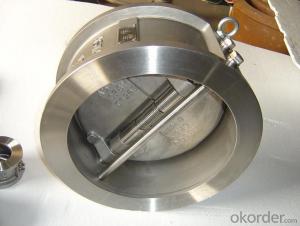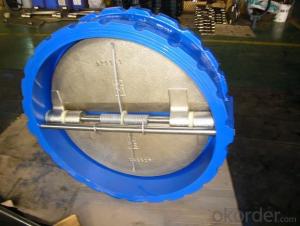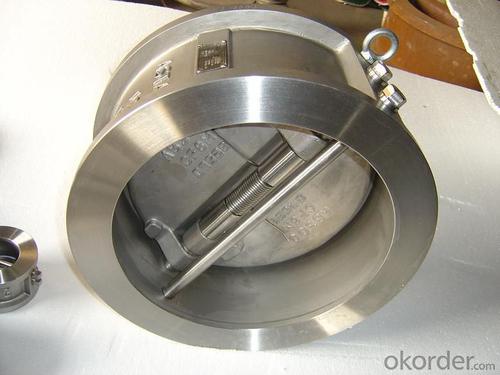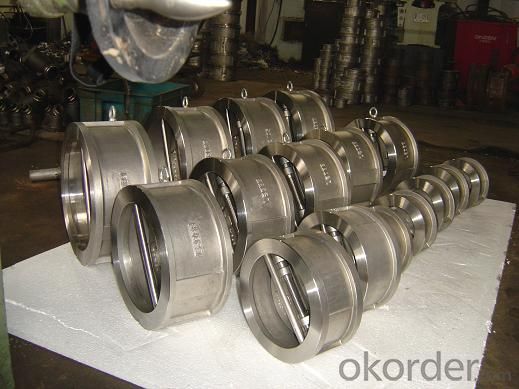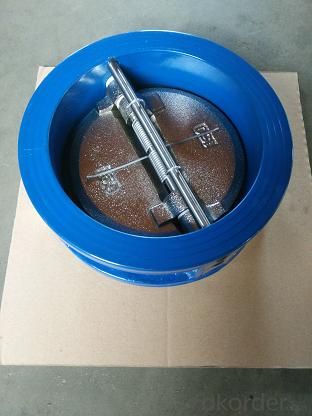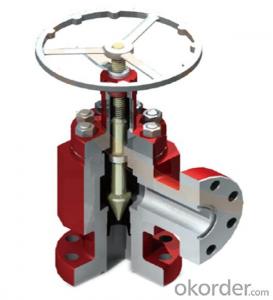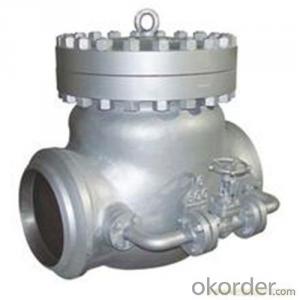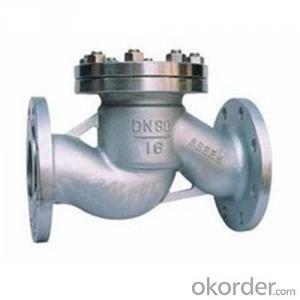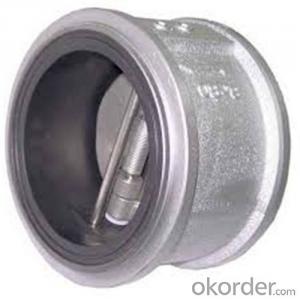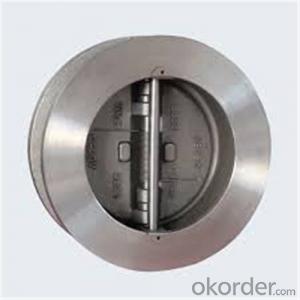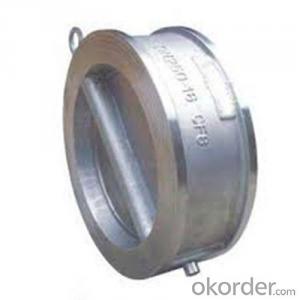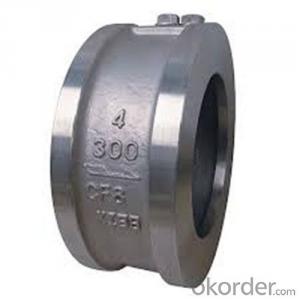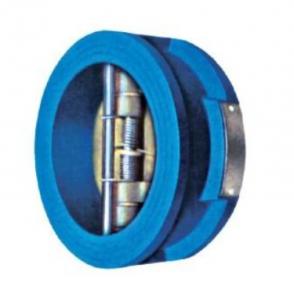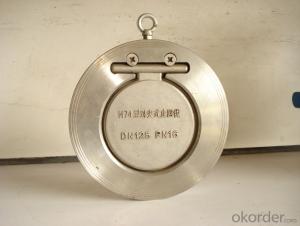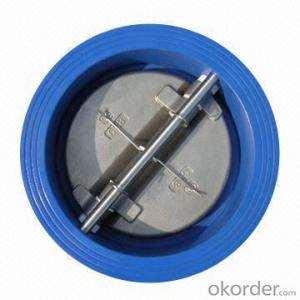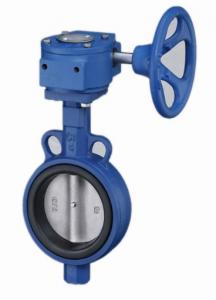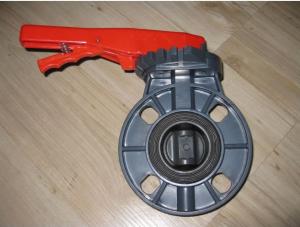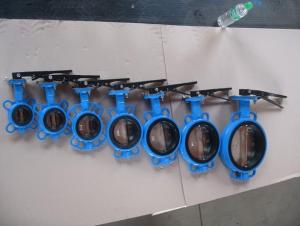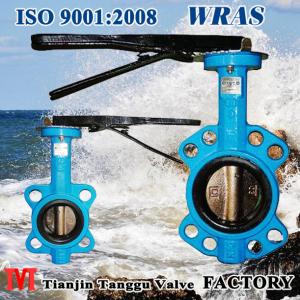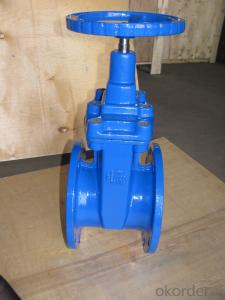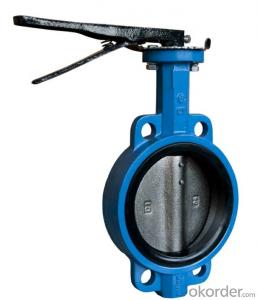wafer type cast iron check valve
- Loading Port:
- China Main Port
- Payment Terms:
- TT OR LC
- Min Order Qty:
- -
- Supply Capability:
- -
OKorder Service Pledge
OKorder Financial Service
You Might Also Like
Specifications
1. High Quality, competitive Price.
2. factory supply.
3. Multilingual s
Advantage:
1. OEM Factory : Professional manufacturer, clients from whole world.
2. High Quality, Competitive Price: Custom is accepted.
3. Complete Service: Long service Life, Fast delivery, Multilingual services.
4. Certificates: ISO9001, CE, NSF, TS, WRAS.
5. Low MOQ: Ready for providing the sample and producing some small orders.
Specification:
Technical Date | Material Specification | ||
Nominal Diameter | DN50-DN600 | Valve Body | Cast Iron or Ductile Iron |
Nominal Pressure | PN10/PN16 |
Valve Disc | Ductile Iron or Stainless Steel |
Operation Temperature | -40°C~225°C | Hand Bar or Hand Wheel | Cast Iron or Aluminium or Carbon Steel or Malleable S teel |
Flange Driling Standard | EN 1902-2 PN10/16 | Seal Material | EPDM OR NBR |
Suface Treatment | Painting |
Stem |
Carbon Steel or Ductile Iron or Stainless Steel |
Application | Portable water, water distribution service & feed lines, sewage disposol, irrigation, fire protection pipe systerm, etc. | ||
- Q: The water won't drain around my outside shutoff valve. The faucet at the valve is not dripping any water. Could it be underground problem?
- i don,t understand your Question.
- Q: what is the average cost to replace a valve core on a car? also can any car shop do it or do i have to go to a conrads etc.
- You can do it yourself very cheaply. All you need to do is go to Walmart or a Auto parts store and get four valve cores and a valve core remover, then go to a gas station the has a air compressor. Remove the valve cores and put the new ones in, you don't have to let all the air out Just put the new valve core in and air the tire back up. I would check the old valve cores before I changed them or have them changed by mixing water and soap together and put in on the top of the valve core, if it bubbles then you need to replace them, if it doesn't bubble someone is just try to scam you.
- Q: Is this possible? The valve is way too big to fit the rim. Is there a special inner tube for this rim? Thanks in advance.
- There are two kinds of valves used on bicycles. The large one, the Schrader valve, is the same as the valve used on cars. The thinner one is the Presta valve. The only possible way to get into the situation you describe is to have a Schrader valve tube and a Presta valve rim. Take the tube back to where you bought it and exchange it for a Presta valve tube. Presta valves are easy to operate. To inflate them, remove the plastic cap if one is there. Fully loosen the fitting at the top of the valve. It will not come off. Inflate the tire to recommended pressure with a Presta valve pump, a pump that automatically does both valve types, or a threaded adapter that will let you use a Schrader valve pump (remove the adapter when done). Then, screw down the fitting that you loosened to start. You really don't need the plastic cap. Their purpose is the keep the valve from puncturing the tube when the whole thing is folded up. Once you've installed the tube in the tire you don't need the cap any more. HTH EDIT: (sorry for shouting) DO NOT DRILL OUT THE RIM! That has the potential for serious safety problems.
- Q: The valve on my mountain bike tire has a leak, so I want to go buy a new valve (and maybe a couple spares)... how much is the average cost?Thanks!
- Pump the tire up to max and then release the air that may clear any dirt out. If it's leaking around the base it needs patched or replaced.
- Q: Hi all, I found oil leakage in my distributor and am about to change the o rings. however, i feel that a blocked PCV valve is causing the pressure to push oil into the distributor. I have been searching for the PCV valve. Can someone please tell me where it is?
- The PCV valve is located beneath the intake manifold on the right (passenger) side. It threads into the breather seperator and points toward the center of the car. To remove it, you'll have to remove the Idle Air Control valve located on the end of the manifold log. Be aware that you'll have to do at least part of this task underneath the car, and that the IAC valve has antifreeze circulating through it Get a mechanic to do it if you can afford it
- Q: the air valve, how does it propel a paintball in a blowback operated paintball gun how does the size/shape/?? of the valve impact how fast the paintball shoots?
- The majority of blowback paintball guns use a pin valve, which is opened when struck by the hammer. The hammer is held in the back position, with the spring compressed, by a sear. When the trigger is pulled, the hammer is propelled forward by the spring, into the valve. These sorts of markers generally use a “stacked tube” design, in which the valve and hammer is contained in the lower tube, while the bolt, which is connected to the hammer, is in the upper tube. The gas released by the valve is then simultaneously channeled up to the bolt to fire the paintball, and back to push the hammer back into the ****** position (hence the name “blowback”). Poppet valves are usually easy to replace and require little, if any, maintenance. The downside to this design, however, is its high operating pressure, which leads to a larger recoil and arguably less accuracy. The valve is usually designed to accommodate a specific operating pressure. Low pressure valves provide quieter operation and increased gas efficiency when tuned properly. However, excessively low pressure can decrease gas efficiency as dramatically as excessively high pressure. The volume of gas released by the valve directly affects the paintball's velocity. The velocity adjuster alters the pretension on the hammer spring which controls how long the pin valve is held open for, or more correctly how much gas must be released to push it back into the ****** position. EDIT - Sorry but wouldn't even know where to start on designing a valve.
- Q: I took my 2nd valve out to wash it (i couldn't find my oil, but it worked fine) and I've tried making the number face the mouthpiece, yet it still is messed up and won't let me play a lot of notes.
- 1) Try this first and if this doesn't work, go to #2. Oil the valve's body and gently put it back into the cylinder without screwing it in yet. Then, turn the valve until it clicks, and make sure it is really seated correct. Some trumpets have two clicks, and one is not the right one. So, you have to get the right click - which tells you that your valve is seated right. When your valve is seated right, then screw it in. 2) If you don't get a click when you spin your valve - look at the tubing on your trumpet and line up the holes in your valve with the tubing. When the valve is up, it will line up with 2 holes of the tubing, and when it is down it will line up with 2 other holes in the tuning. So, you can determine the correct positioning of the valve by looking at the tubing on your trumpet. But this is a last resort. I've never seen a trumpet where the valves don't click when you turn them.
- Q: My mum (73, non-smoker, not overweight) has been diagnosed with 2nd degree aortic valve stenosis 5 years ago. Now deteriorating. Her cardiologist sees her every 6 months and strongly recommends surgery. She is too scared as dad died during a coronary bypass op. Any tips how to gently make her feel better about the op? She heard on the radio that some valve replacements can be done via catheter, not necessitating open heart surgery and heart-lung-bypass. Is that true for aortic valves and is it likely to become mainstream soon? She lives in Germany, so I guess good centres would be Munich, Wuerzburg and Heidelberg. Any views very appreciated!
- Without surgery, a person with aortic stenosis who has angina or signs of heart failure may do poorly. Possible Complications * Arrhythmias * Endocarditis * Left-sided heart failure * Left ventricular hypertrophy (enlargement) caused by the extra work of pushing blood through the narrowed valve Aortic stenosis can be cured with surgery. After surgery there is a risk for irregular heart rhythms, which can cause sudden death, and blood clots, which can cause a stroke. There is also a risk that the new valve will stop working and need to be replaced. According to a prospective, single-center, nonrandomized study of 25 patients, percutaneous implantation of an aortic valve prosthesis in high risk patients with aortic stenosis results in marked hemodynamic and clinical improvement when successfully completed. Medium- and long-term results are unknown. When selecting the optimal therapy for individual patients, the percutaneous approach must be carefully weighed against the excellent results achieved with conventional surgery. Please note that I am not a medical professional.
- Q: I'm thinking of buying a used 2006 Volkswagen Jetta. It has a 1.5 liter 20 valve engine, and I really don't know what that means. That's good, right?And is this a good used car to buy?
- Valves are what allow the air into the cylinders and the exhaust gasses out. Cars used to only have two valves per cylinder... one to let air in and the other to let exhaust gas out, but lately cars come with more than two per cylinder. This allows the air to come in faster (with less restriction) and the exhaust gas to exit faster. Generally the number of valves isn't important, and I have no experience with Volkswagens, so I can't tell you if that's a good model to buy. Check with the Kelly Blue Book (or any similar reference book) to determine if the condition of the car and the number of miles on it are reasonable for the asking price.
- Q: I have a Chevy Silverado 2500 5.7L V8. I have been having problems with passing smog. First one failed because it needed a new cat. Replaced it and tested again. NOx emissions are off the chart (1450/1006 max of 992/59615/25mph). I replaced the EGR valve based on a suggestion. Quick test today said the NOx emissions are still way off. Suggested that I change the EGR solenoid valve and also pull the EGR valve and use a coat hanger to clean some of the carbon build up. I purchased a new solenoid today but looking at it I noticed something. Since there are what are appear to be two ports on one side of the solenoid, I must have replaced the vacuum hose onto the wrong one after replacing the EGR valve. How much would this make a difference on the test readings taken? Would it be beneficial to just replace the solenoid anyway or try to test again with the current one but connected properly?
- This Site Might Help You. RE: What would happen if the EGR solenoid valve isn't connected properly? I have a Chevy Silverado 2500 5.7L V8. I have been having problems with passing smog. First one failed because it needed a new cat. Replaced it and tested again. NOx emissions are off the chart (1450/1006 max of 992/59615/25mph). I replaced the EGR valve based on a suggestion. Quick test today...
Send your message to us
wafer type cast iron check valve
- Loading Port:
- China Main Port
- Payment Terms:
- TT OR LC
- Min Order Qty:
- -
- Supply Capability:
- -
OKorder Service Pledge
OKorder Financial Service
Similar products
Hot products
Hot Searches
Related keywords
